Search Results
Filter by Topic
How Immigrant Entrepreneurs are Making America Great Again
How Immigrant Entrepreneurs are Making America Great Again
General Immigration Information
Last Updated: January 15, 2020.
In polls, Americans and immigrants alike overwhelmingly cite economic opportunities as the number one reason people choose to immigrate to the United States (74%). About half of Americans believe that once immigrants are here, their talents, experiences and hard work strengthen our nation and in particular improve food, music, and the arts while around a quarter of Americans say they have a friend or relative who has recently immigrated to the U.S. While many can agree that immigrants have the potential to add economic, cultural, and social value to a place, some U.S. cities have gone as far as declare that immigrants are "imperative" to their continued growth and success.
It is no secret that both our nation's demographics and economic mainstays are changing. More and more baby boomers continue to retire and less and less babies are being born, so it naturally follows that the native-born American workforce is shrinking. Globalization has taken a toll on domestic manufacturing companies, something that American metropolitan areas have been tied to in the past. Those deft enough to notice these changes and recognize their consequences are making plans to adapt and are turning to immigrants for the answer.

According to a report by the American Immigration Council, "Cities and regions looking to stem population decline and stimulate economic growth are seeking to attract immigrants and encourage immigrant entrepreneurship. Immigrants play an important role in establishing “main street” businesses (retail, accommodation and food services, and neighborhood services), which are important for generating neighborhood-level economic growth and revitalization.” The numbers support this claim with immigrants making up about 13 percent of the country’s total population, 16 percent of the labor force, 18 percent of business owners, and a whopping 28 percent of “main street” business owners nationally.
After recognizing that immigrants run the majority of shops in the "Little Village", with the second highest business tax revenues in the city, Chicago, Illinois decided to embrace this entrepreneurial vibrancy with their "New Americans Plan". With the tagline, "Chicago Welcomes the World", this plan espouses the goal of making Chicago the most immigrant-friendly city in the world. An advisory committee made up of 50 business, academic, civic, philanthropic, community and immigrant advocacy leaders meet regularly to develop immigrant-friendly strategies and ensure Chicago’s status as a "vibrant and welcoming international city". Initiatives from this committee range from the creation of a small business incubator and the promotion of tourism in immigrant neighborhoods to parent engagement centers and city employee cultural sensitivity training.
Around the same time, Dayton, Ohio launched the "Welcome Dayton" plan involving over 100 members of the community which states, “communities across America are at a crossroad: to welcome and integrate new residents and help them on a path to citizenship, or to allow old stereotypes, fears and misconceptions to hinder future success.” In order to capitalize on the economic potential in its immigrant-dense neighborhoods, Dayton community leaders provide education to all potential entrepreneurs about the many local services that are available to help make their ideas a reality.

In Nashville, Tennessee which is considered to be a relatively new immigrant destination, nonprofits and community-based organizations such as Tennessee Immigrant and Refugee Rights Coalition (TIRRC) and Conexión Américas have led the way in the promotion of immigrant entrepreneurship. The city has focused on three inter-dependent areas of integration: social, economic, and civic. Nashville has even established the Mayor’s New Americans Advisory Council and the Mayor's Office of New Americans (MONA) with a goal to give "New Americans the tools they need to access economic and educational opportunities—to the benefit of all Nashvillians.”
A fourth and more recent example took place last year, when Salt Lake City Mayor Ben McAdams and Salt Lake City Chamber President Lane Beattie announced the "New Americans Task Force", aimed to welcome and encourage foreign-born entrepreneurs in the state of Utah. According to Mayor McAdams, "Welcoming people here is not only the compassionate thing to do for our community, but it also brings resiliency and vibrancy to our economy. We all know that our country, and especially our state, is growing rapidly. It turns out that much of that growth is due to a jump in the percentage of residents who were foreign-born. They are adding to our strong economy." This bold move to reshape local business and government policy makes sense knowing that immigrants contributed $8 billion to Salt Lake County in 2014 alone.
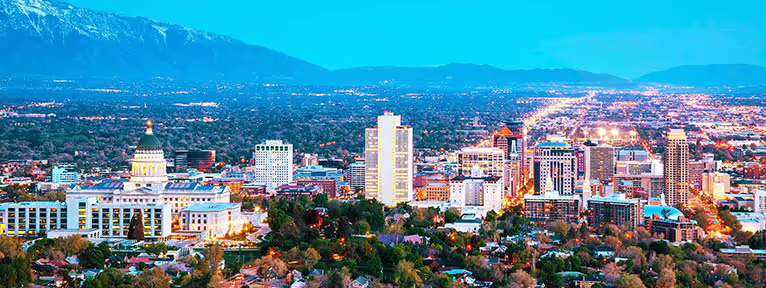
The Queen of Alterations
One woman, who immigrated to Bountiful, Utah, just north of Salt Lake City, from the Philippines at age 32, felt welcomed and encouraged by her community to follow her dream and run a business as a seamstress.

Ever since she was a little girl, Leilani Drumm loved to sew. "As a kid, I would find paper and cut out a little dress. I ended up getting a degree in accounting but all I really wanted to do was sew." When Leilani followed her new husband to his military base in Utah, she held jobs at a variety of places, including the military base and later a factory and a department store. When Leilani's husband sustained a back injury and was forced to change careers, money became very tight. As Leilani put it, " At first I had nothing here - life was really hard." Things changed when Leilani's friend, a recent immigrant from Japan, told her about the alteration business she'd started. Leilani was confident in her skills because she knew she could do more than just small alterations, she was a dressmaker. That friend went on to encourage Leilani in a conversation that she refers to as a stepping stone, "She really helped me get out of my shell." Shortly before her idea became a reality, Leilani found out that she was pregnant. "I call her my lucky baby. I got pregnant, then I got the business, and that was the start of everything!" That was almost 19 years ago. "Now my daughter is going to college and I am able to support her with my same business and it's such a blessing."
Leilani has largely felt comfortable and welcomed in her community. The people, she says, are what she likes the best about living in America. "They're all just really nice. If I ever have a problem here I know they will help me right away because they know me already." That same kindness is what seems to be the key to her shop's success. "To start a business, first of all, you need to be friendly! A lot of the people keep coming back and they tell me not to go anywhere - they like me a lot." Leilani is not exaggerating, either. Many of her customers bring business from across county lines and some even travel from out of state. In a business that mostly gains customers through word of mouth, connection is crucial. Leilani feels it's important to try and relate to the challenges her customers are having. "Most of my customers have troubles in their life and sometimes they're depressed about something. I tell them they can just come to my shop one day and we can talk about it. Sometimes I will even take them to lunch. I try to help them with their feelings. I really do listen and I think that's the best way to be connected to people." Policemen or veterans are especially welcome at Leilani's with a special rate. She also tries to give discounts in a situation where she can tell money is tight because she says she "understands their feelings".
Of course working with people all day isn't always easy. "I really like my job but it can be stressful with all the wedding dresses and before prom. There's always one customer out of a hundred each year that's really hard to deal with. But usually my customers are really thankful and seeing them really happy with the work I did, is payment enough. When I see my wedding dresses from start to finish, I really am so happy and proud that I can do that for people." It's not just Leilani's personal skills that keep her customers returning, but the quality of her work. Most of her competitors only do little alterations that don't last very long. "There's a cleaner near the post office and they even bring their work to me because they know I just want to do the job right!", she laughs and adds, "I don't think they know how to sew..."
Leilani's advice to new entrepreneurs is trite but true, "You have to work really hard. Just go, go, go, until you get what you want. Trust in yourself and in your abilities. Don't think negative things, only positive things. Don't be afraid. The more you walk forward and do hard things, I think you can make it." Just listening to Leilani makes it clear that it doesn't hurt to love what you're doing, either. "As long as you are happy with what you are doing, you will be successful. If you're new here, follow your dream! Go forward. Find what's good for you and don't stop." Leilani is clearly speaking from experience of the past two decades being a labor of love as she concludes after a brief moment of reflection, "I think this is my dream."
A Legacy of Entrepreneurship
Hugo grew up on a little ranch in Matatenas Vallecillo, Nuevo León, Mexico, about an hour south of the Laredo Texas border. As a nine year old, Hugo lost his father and had to drop out of school to help support his family and newly single mother. As an eighteen year old, with very broken English and only a 2nd grade education, Hugo decided to immigrate to the United States. Hugo went where the work was, which led him to Michigan, both North and South Dakota - pretty much every state where people were picking. He eventually landed in Richgrove, California to pick grapes where he would meet and marry his Wasco-native wife, Mary.

Hugo was a quick learner and a hard worker and soon became a foreman for local farm labor contractor, Bob Fortune. He was Bob's loyal employee for years and years, until one day, seemingly without warning, Hugo was let go. At the age of 47 with a mortgage and three young kids at home, Hugo knew he had to figure things out and fast. Mary told her husband that he needed to start his own business and simply go to the farmers and tell them he would bring the crews from now on. Thinking they had no money and knowing the risks, Hugo was understandably very scared but his dear wife wasn't ready to give up. Unbeknownst to Hugo, she had secretly saved $10,000 for such a time as this. With the encouragement of his strong and loving partner, he approached each farmer individually and asked for their business. His reputation as a man with a tireless work ethic served him well and farmer after farmer agreed to pay him. It was never Hugo's dream to start his own business, but he felt like it was his only choice and he rose to the challenge. Night after night, Mary and Hugo would return from the fields to go over all the paperwork and make sure the numbers were right. Hugo didn't know accounting but he was naturally good with numbers. Mary only had a 10th grade education. But together, they figured it out and eventually did well enough where they could hire bookkeepers to keep track of everything. They may not have known pricing strategies or cash flow statements but they knew exactly how many boxes of harvest per row it takes to fill a bin to the brim. They may not have known business but they knew their business and that was enough. Enough to gross over $10 million a year and oversee up to 350 employees at any given time. Much like his teams in the vineyards, Hugo continued to meticulously prune and craft his business for over 36 years. At 83, Hugo passed away, having truly worked every day up until the very end of his life.
Mary is now retired but the business has stayed in the family, under the direction their son, Roel. For two people who never "meant" to be entrepreneurs, they have set quite the pattern for their three children, who have started and owned four different successful businesses at various points in time. One of their children, Victor, attributes this to the fact that "We're pretty independent people. A big part of it is probably that we don't like other people telling us what to do. We like the challenge of starting something from nothing and trying to grow it." A challenge that seems in many ways even more daunting for the previous generation. "I can't imagine going to another country and trying to start a new business while trying to take care of my family." Victor speaks honestly, clearly in awe of what his parents were able to achieve. He continues, "My dad never talked to us about 'business'. But what we've learned most from watching my parents is work ethic - how to spend your time wisely and earn a living. They grew up so poor and when they saw that they could do better, they never wanted that to go away - they just wanted to work. And that's what they did." As an uneducated immigrant who struggled with English his entire life, Hugo often felt different from the community in which he lived and worked. Although Victor never felt that same isolation, he noticed it in his father and saw how ownership of a business affected Hugo in more than just economic ways. "I think it took my dad quite a long time to adjust...It probably wasn't until he was successful in his business that he started to feel comfortable with who he was in America."
He noted yet another benefit was the great sense of love and unity between his parents. "Starting the business was tough on their marriage of course, but they got through it together and my mom always loved and supported my dad until the day he passed." In an attempt to summarize these impactful memories and experiences into a digestible moral of sorts, Victor repeats a similar theme to Leilani. "Anything you want in life, you can make it happen. You just have to visualize it, and go after it. I know a lot people worry about how they are going to pay the bills - that story was my dad. But he found a way, he and my mom. I think the most important part of this was my mom. If it wasn’t for her telling him he could do it, he would have never done it. I think that’s true in life, when you have a good partner, you can make anything happen."

Individuals who are living in communities with immigrants are 36% more likely to feel positively about immigrants than those who say there are no immigrants living in their community. This seems intuitive enough, doesn't it? Familiarity tends to increase understanding. When these immigrants are our neighbors, our friends, our brother-in-laws, our florists, we are more prone to recognize their strengths and celebrate their successes. We are more prone to reap the benefits of diversity if they are nearby- if we are grabbing a delicious gyro on our commute home from work or if we are looking forward to the traditional dance and music shows at the Asian festival on the weekend. Viewing the one million plus newcomers each year as a lump sum, as opposed to widely diverse individuals with widely diverse backgrounds, interests, and aptitudes, leads to both misunderstandings and misrepresentations of the situation at hand. Perhaps the best way to change the perception of immigrants as burdens to that of important contributors is to remove the plural and let each person share their own story.
What is Class of Admission on Form I-90?
Learn about Class of Admission on Form I-90.
USCIS Forms
Last Updated: January 15, 2020.
Filling out government forms is never a walk in the park, and mistakes can lead to costs and delays. Confidence in what kind of information your I-90 application is asking for takes a lot of stress out of your submission. Off the tops of our heads, most of us don’t know what our “class of admission” is, so let’s start with that.

Your Class of Admission is asked on Item Number 14 on your Form I-90. Essentially this 3-digit code identifies the category of your lawful residence status. For example, you could be identified as a "Self Petition unmarried son/daughter - of US Citizen - Family Sponsored First Preference" aka B16, or a "Brother or sister of a country-region place U.S. citizen" (F41). There are hundreds of 3-digit codes that correspond with each of these categories, the complete USCIS list can be found here, but the best way to know how you were classified is to look at your Permanent Resident Card under Category. It is typically one or two letters followed by a single number.
To be clear, this states the status under which you were granted permanent residence, not the category that you entered the United States under. If you have more questions about form I-90, check out this article.
Michelle: My Immigration Story
Read to learn more about Michelle's Immigration Story.
General Immigration Information
Last Updated: January 15, 2020.
The journey began in Mexico right before Christmas. My mother picked me and my sister up early from school one day. I remember my sister and I were overjoyed to see her because she was usually busy with work and didn't have time to pick us up from school. I was only seven years old then, and I had no idea my life was about to change forever. Everything seemed normal as I packed a small backpack when I got home, and I still didn't know we were leaving when my mother gave me and my sister and early Christmas present that night right before we boarded a Greyhound bus. I think it all started to sink in when I arrived in Utah and I saw the snow falling. I had never seen snow before. It was cold but I ran around trying to catch it as it fell in flurries to the ground. We were in America now, and we were going to make it our home.

My first challenge was learning English. The kids at my elementary school crowded around me during recess and lunch and kept trying to get me to talk to them. They would hold up basketballs, or point at chairs and ask me questions. I had no idea what they wanted, and the professors didn't know what I needed either. I would often make gestures to get permission to go to the bathroom, or mimic what I heard my classmates say even if I had no idea what the words meant. My mother was having similar problems. She walked up and down the grocery store aisles not knowing what kind of food she was getting or what the cashier was telling her. It got worse when my sister and I began speaking our school learned English at home, which wasn't very good, but much more advanced than the English my mother spoke. My mother had no idea what we were saying to each other. That was when she decided we all had to learn to speak, read, and write English. She signed me and my sister up for a special reading class during the school year and a summer reading program. My mother also began volunteering at our local library and joined me and my sister when we attended the library activities. She did reading and writing homework with us and would go out of her way to speak English with whoever would listen. She even joined the PTA of my elementary school to practice her speaking with my teachers and peers. She did this for years, and I remember my mom gave a lesson to my technology class when I was in jr. high. She still spoke with a heavy accent, but her reading and writing skills were as strong as mine by that time, and she understood English just as well.

I was about fourteen years old when my mother got remarried, but it was not until I was in high school that we began thinking seriously about getting our green cards. Up until then, we had been undocumented and hadn't thought much of changing our legal status, but I was starting to think about furthering my education and realized that I didn't have a social security number and could not apply for admittance to universities or for loans to help me pay tuition. Without a green card, my education would end after high school not because I didn't want to study, but because I couldn't apply. I discussed my worries with my mother. She listened and decided that it was time to get our green cards.
My mother began asking her friends for help. Most of them told her to look it up online. When she ran a search for green cards a huge list of attorneys came up. All of them were asking for high amounts of fees to fill out forms and get appointments. The prices ranged from 400-1500 dollars just to start the applications. We didn't have that kind of money. My mother was a cleaning lady and we hardly had enough to make it from month to month. There was no way we could hire an attorney. She told me and my sister about how hopeless it all seemed as she drove us home from school one day, and we all got scared and I began to cancel all of my plans to further my education. This broke my mother's heart. She didn't come all the way to America for us to give up. We had to find a way to obtain our green cards and eventually citizenship.
My mother found a Hispanic center close to our home and it was there that she found out about the USCIS.gov website. It was free and had instructions on what forms to fill, documents to gather, and steps to take in order to get a green card. While my sister and I went to school she went to the library and the computer there to read the instructions and print forms. If she didn't understand something she would get a library assistant to help. She also called and visited the USCIS field office and visited the local Hispanic Center frequently for more complicated questions. She had to gather her previous divorce papers, all of our birth certificates, passports, and other documents that were listed in the instructions. What I remember the most was when we all had to get our vaccinations up to date. My sister and I only had to get the tuberculosis test because we had been going to school and needed to get shots regularly, but my mother had to get almost seven shots in one doctor's visit. We also visited the Mexican Consulate to gather documents and have more questions cleared up. I remember that every Sunday my mother would sit on her bed and fill out forms and put together folders. Sometimes I sat on the bed and helped her out.
Overall, it took us two years to gather everything we needed. We each had our own folder stuffed with forms and documents. We mailed them in and waited. We were afraid and one time my mother sat me and my sister down and explained that because we had been undocumented for some years, there was a small chance that we might get deported for a year before we got our green cards, but that we should not be afraid. After six months we got the letters for our interviews. Our cases had been processed and if we did well in the interview we would get out green cards. We woke up early, dressed up in our nicest clothes, and did our hair. We arrived at the time we were scheduled and waited in a large room filled with chairs. A few others were in the waiting room with us, all looking as nice and nervous as us. We waited for two hours before they called us in. My mother, step-father, sister, and I walked in. The room was a small and very short man with glasses sat at the other side of a desk. He called us all by name to make sure we were all present. He looked at my mother and said, "Everything looks ok. We have all of your documents." We all smiled, and I remember I clutched my hands tightly together on my lap. He continued his speech. "I just have one question for you. Do you have any kind of proof that you all do things as a family? Do you have family passes or memberships to parks or events that you can show me?" We all looked at each other. We went to the movies every weekend, went swimming, had dinner together, and went to church but we had no way of proving it. My mother thought for a minute and then opened up her wallet. She pulled out a membership for the Clark Planetarium in Salt Lake City. My step-father, sister, and I followed her lead and pulled out our memberships too. The man smiled. "Alright. Congratulations," he said, and we all took a sigh of relief. My mother almost began to cry and she asked the man if she could give him a hug. He politely denied and shook all of our hands instead. We all hugged each other when we reached the parking lot and laughed and decided to go out to dinner to celebrate and we smiled and celebrated again when our green cards arrived in the mail a couple of months later. All the time, effort, and persistence paid off and my mother, sister, and I were finally permanent residents of the United States.
That victory was seven years ago, and thanks to my mother's hard work I am now about to graduate from Brigham Young University and my sister has a good job and has bought a house with her new husband. Currently, we are all going through the process of getting our citizenship. This has been much easier. Again, my mother has done all the work herself with the help of the USCIS.gov website. Since we are all adults now, we were able to work and save money to pay the necessary fees in about a year. Just the other day we all received our appointments for our interviews where we will turn in our green cards and be sworn in. My sister and I don't have to take a government or language test because we went through the public school system, but my mother got a list of books to get so she can begin studying for her exams. The books are inexpensive and she is excited to look over them and study when they arrive in a couple of weeks. Again, we are all a bit nervous but we are also relieved that we were able to get this far with free resources and hard work.
How to Apply For a Green Card
This article explains the different ways to apply for a green card.
Green Card Application
Updated: May 12, 2022
For Español click here.
Getting a Green Card means you have been authorized to live and work in the United States on a permanent basis.
In addition to living and working in the U.S. permanently, there are numerous other benefits of getting a green card:
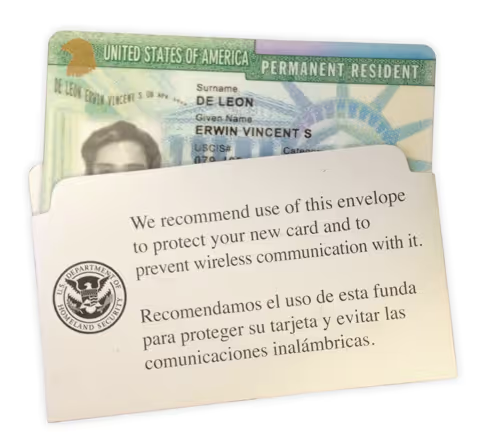
- You can now sponsor family applying for their own green cards.
- You may travel outside the U.S. and return without disrupting your status.
- Once you've had your green card for five years, you may apply to become a U.S. citizen.
- You are eligible to receive Social Security benefits after 10 years of work.
- You qualify for in-state tuition.
How to Become a Permanent Resident
There are a few different ways you may become a green card holder:
- Sponsorship by a family member in the United States.
- Sponsorship by an employer's offer of permanent employment in the United States or through your own entrepreneurship.
- Through attaining refugee or asylee status or through another humanitarian program.
To qualify for a green card, you must fall into one of the available immigrant categories.
Available Immigrant Categories:
- Family-based
- Job or employment-based
- Based on refugee or asylum status
a. Family-Based
You may qualify for a green card if you are:
- An immediate relative of a U.S. citizen. This includes spouses, unmarried children under the age of 21, and parents of U.S. citizens age 21 or older.
- Another family member of a U.S. citizen. This includes unmarried children over the age of 21, married children of any age, and brothers and sisters of U.S. citizens age 21 or older.
- A family member of a lawful permanent resident. This includes spouses and unmarried children of the sponsoring lawful permanent resident.
If you fall into one of the above categories, you can learn how to prepare a family-based green card application with SimpleCitizen here.
In addition to the above categories, being a member of another special category may qualify you to get a green card based on family. These include being a:
- Battered spouse or child
- A K nonimmigrant
- A person born to a foreign diplomat in the United States
- A V nonimmigrant
- A widow(er) of a U.S. citizen
Important to note: There is an order of preference for people who wish to immigrate to the U.S. based on family. First preference goes to the first category listed above, immediate relatives of a U.S. citizen. To see the complete order of preference for family members, visit the USCIS website.
b. Job or Employment-Based
You may qualify for a green card based on a job offer or your plans to invest in the U.S. economy and create jobs. The employment-based category includes:
- Green card through a job offer. This is also known as sponsorship through an employer — in other words, when an employer sponsors your green card application.
- Green card through investment or entrepreneurship. Immigrant investors/entrepreneurs who are investing in a U.S. - based business that creates new U.S. jobs may be eligible for a green card.
Green card through special categories of jobs. You may be able to get a green card based on having a past or current job in one of the following special categories set forth by the U.S. government:
- Afghan/Iraqi translator
- Armed forces member
- Broadcaster
- International organization employee
- Iraqi who assisted the U.S. government
- Afghan who assisted the U.S. government
- NATO-6 Nonimmigrant
- Panama Canal employee
- Physician National Interest Waiver
- Religious worker
c. Refugee or Asylum Status
You may be able to get a green card through your status as a refugee or asylee.
- If you're a refugee, the law requires you to apply for your green card within a year of entering the U.S.
- If you have been granted asylum in the U.S., the law requires you to apply for your green card within a year of asylum status being granted.
Filing an Immigrant Petition
If you belong to one of the above categories, next you will need an immigrant petition filed on your behalf. The petition establishes the basis for your immigration and the classification or category in which you belong.
- For people immigrating based on family, the petitioner will file Form I-130, Petition for Alien Relative. Click here to start a family-based petition.
- For people immigrating based on employment, the petitioner will file Form I-140, Immigrant Petition for Alien Worker
How to find out if you are eligible to apply
Everyone who wishes to get an immigrant visa (and apply for any subsequent status adjustment) must prove that they are eligible for admission to the United States.
What would make someone inadmissible? The grounds of inadmissibility are set by Congress and are particular to the category under which you are immigrating. These factors include:
- Financial reasons. The relative who sponsors you must be able to support you.
- Health-related reasons. You cannot have a disease that makes you a public health risk.
- Immigration history. If you've ever entered the U.S. illegally or overstayed a visa by six months or longer, you may be deemed inadmissible.
- Criminal history. Applicants who have been charged and/or convicted of certain crimes, such as violent felonies, drug offenses and terrorism, may be deemed inadmissible.
SimpleCitizen's Eligibility Quiz
In order to make sure you are eligible to apply and that you choose the correct application for your situation, you can use SimpleCitizen's free eligibility quiz here.
By answering just a few easy questions you can determine if you are eligible to apply. Here's how it works:
If you have a questions about your eligibility or are unsure how to get started, here are a few options:
Sign up for SimpleCitizen & take the guesswork out of the Green Card process
You don't have to try to navigate the green card process yourself, and you don't have to pay outrageous attorney fees. SimpleCitizen's easy to use software will guide you through the whole green card application.
Apply for a green card at the fraction of the cost of using an attorney — with all the comfort of having a guide along the way.
Your American dream awaits you, and SimpleCitizen can help you achieve it.
Click here to start your application.
Best Non-Profits for Immigration Help
Nonprofits that have proven results in facilitating a better experience for immigrants in the US.
General Immigration Information
Last Updated: January 15, 2025
Here at SimpleCitizen we provide immigrants with tools and expertise in order to make your status goals here achievable. Of course there many organizations that recognize the value of welcoming those that share the American dream. In order to give you the necessary tools to accomplish you goals, here are descriptions of nonprofits that have proven results in facilitating a better experience for immigrants of America.
In no particular order...
Refugees
International Rescue Committee - Better Aid

The world’s more than 60 million displaced people, the highest number ever recorded, require more than “aid as usual.” Their growing and increasingly complex needs mandate a transformation—a creative rethinking—in the global humanitarian response. The International Rescue Committee has taken on this challenge.[/caption]
The IRC works all around the world with a wide variety of issues, in the United States alone the IRC helped resettle 13,400 refugees in 2016. They have a very holistic approach to resettlement, primarily focused on immigrants that are fleeing a crisis. The IRC was started 80 years ago by Albert Einstein, whose genius seems to have penetrated the organization to this day. Fast Company claims that "...none that can rival its ability to help refugees and displaced people at every stage, from emergency response to resettlement..."
With such a wide variety of help across the entire nation, the IRC is one of the top resources for refugees. You can get the contact info of branches all over the world here. It'd be impossible to go over all the services they offer in this article, but you can take a look at what they do in Education, Health, Economic Wellbeing, Empowerment, Safety and Gender equality on their website. Did we mention they have a very holistic approach? And if you want to join the cause, they also have a variety of volunteer and internship opportunities.
Deportation
For those threatened by deportation it can feel like such a life-changing event is completely out of your hands. Both United We Dream and Families for Freedom are committed to giving immigrants the tools to empower those in the face of deportation.
United We Dream - Immigrant youth building a movement for justice

Over 100,000 immigrant youth and allies. Fifty-five affiliate organizations. Twenty-six states. Oh, and its a youth-led organization. United We Dream has a huge network that they use to run immigrant-related political campaigns like stopping deportations and access to higher education. They have even branched into the "intersection of queer and immigrant rights." If any of these issues are relevant to you, then you can Get Help! You can also find a local group to participate in here.
Whether there is a local group near you or not, United We Dream has provided a Toolkit to help immigrants all over America. Their website includes an ICE activity reporting hotline as well as Deportation Defense Cards that you can download in multiple languages. They recommend that if you feel threatened by deportation to keep the card with you at all times.
Families for Freedom - "As long as deportations and unjust immigration policies continue we will continue to fight to keep our families together"
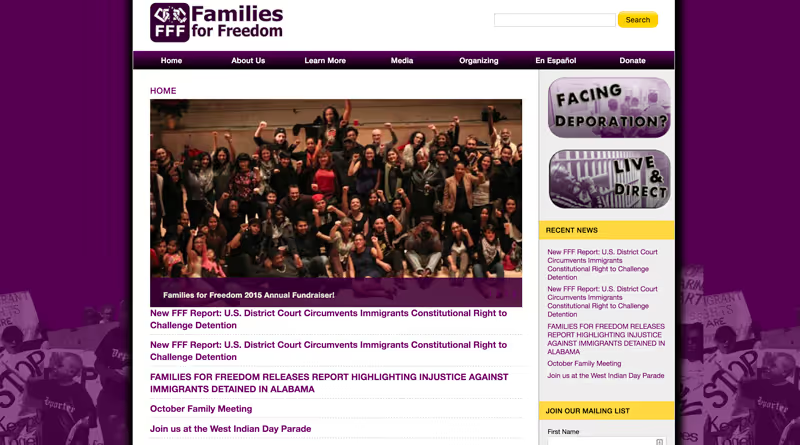
Founded in September 2002, Families for Freedom is a New York-based multi-ethnic human rights organization by and for families facing and fighting deportation.[/caption]
FFF started in response to the persecution to the often unmentioned victims of 9/11, when the wave of fear that followed one of America's greatest tragedies became directed to innocent Arabs and Muslims. FFF started with three families in a small apartment, you can read their powerful story on their The History of Families for Freedom page. Although initially FFF was focused on helping Arabs and Muslims, they have since expanded their net to include all immigrants. Like United We Dream, FFF has resources for understanding deportation threats, how to behave when your are threatened by deportation, understanding your rights, and a deportation hotline as well.
Both of these nonprofits are a powerful example of grassroots mobility and the power that average people with with a unified cause. If you feel threatened by deportation, start becoming familiar with their tools today.
Community Resources and Integration
Moving into new communities as an immigrant is full of challenges. Welcoming America and the U.S. Committee for Refugees and Immigrants use their vast network to support immigrants and the organizations that want to greet them in America.
Welcoming America - Building a Nation of Neighbors
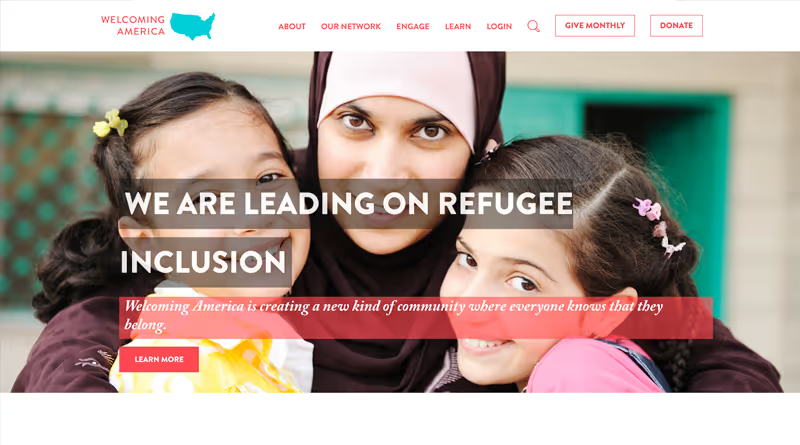
Welcoming America began after founder David Lubelli's method for transforming the community mindset in Nashville began being copied other parts of the country. After realizing the potential of the the strategy he had implemented, David first went to Harvard for a year to study policy and social psychology, and to perfect his method. Then came Welcoming America, a platform to make the communities more "fertile" for welcoming immigrants. David recently got the Charles Bronfman Prize, and you can be rest assured any organization found on their Network Map will have been trained to fully support your integration in the community.
U.S. Committee for Refugees and Immigrants
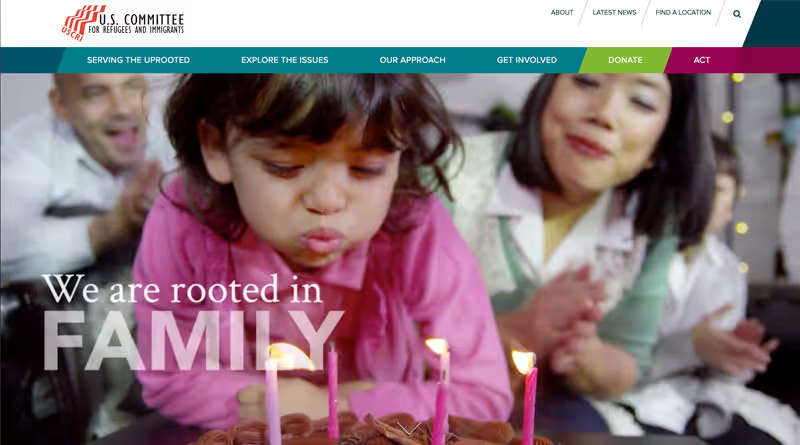
Founded in 1911, the U.S. Committee for Refugees and Immigrants has deep roots in watching over vulnerable immigrant communities. Their rich history and commitment to providing homes for the needy has made them a leader in determining what needs to be facilitated to help immigrants be successful in America. This makes both the Committee's own offices and their partners a trusted resource. For the four offices in New York, Iowa, Virginia, and North Carolina, some of the services they provide include:
- Naturalization
- Asylum
- Special Immigrant Juvenile Status (SIJS)
- Family-based Immigration Petitions/Applications
- Consular Processing
- Adjustment of Status Applications
- Work Authorization
- Green Card Renewal Applications
- Self-Petitions for Battered Spouses and Children (VAWA)
- Temporary Protected Status (TPS)
- T Visa (victims of human trafficking)
- U Visa (victims of crime)
- Removal of Conditions to Permanent Resident Status
- Removal Proceedings
Of course their network of 97 partner organizations is another valuable asset. You can view their agency map here.
Immigrant Rights
American Immigration Council - Honoring our Immigrant Past, Shaping our Immigrant Future
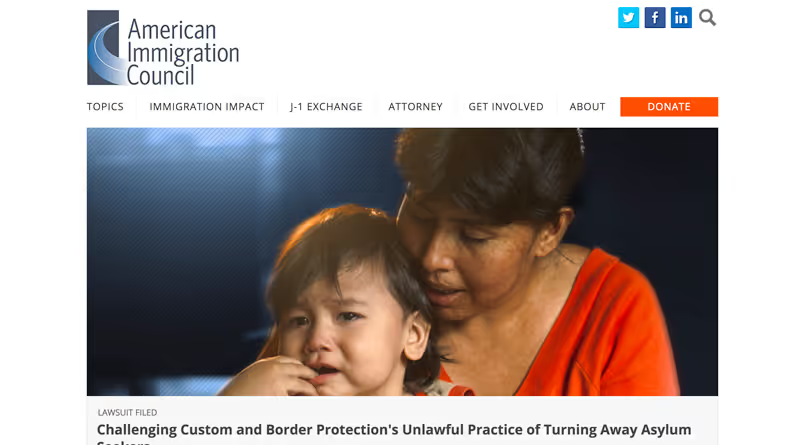
Shaping our immigrant future.
Hopefully you will never need the American Immigration Council's direct services. As one of the heavy hitters among immigration litigation, they deal in the most critical immigration cases that shapes how the country interprets immigration law. In fact, they are so important that they will never resort to shortening their name in an acronym, instead referring to themselves as "the Council."
The Council has done a lot of good for the rights of immigrants. They are a nationwide fearless defender of fair interpretation of the law. When government agencies neglect or oppose their duty to uphold immigrant rights, the council will not hold back punches. You can read a Washington Post article about the Council's law suit against top U.S. officials including Homeland Security Secretary John F. Kelly here. In a time where the norms of government are being disrupted left and right, the American Immigration Council serves as a nonpartisan advocate for respect and accountability in immigration law.
In addition, the Council provides of valuable research to inform the public with their website http://immigrationimpact.com. It's a great resource for staying up-to-date on immigration news and developing issues. In their own words "The Council is a national leader in challenging the myths and misinformation that too often dominate the political and public debate around immigration." Finally, the Council has an Exchange Visitor Program which utilizes the J Visa sponsorship to enhance and promote cultural exchange.
Benefits
Immi - Understanding Your Options
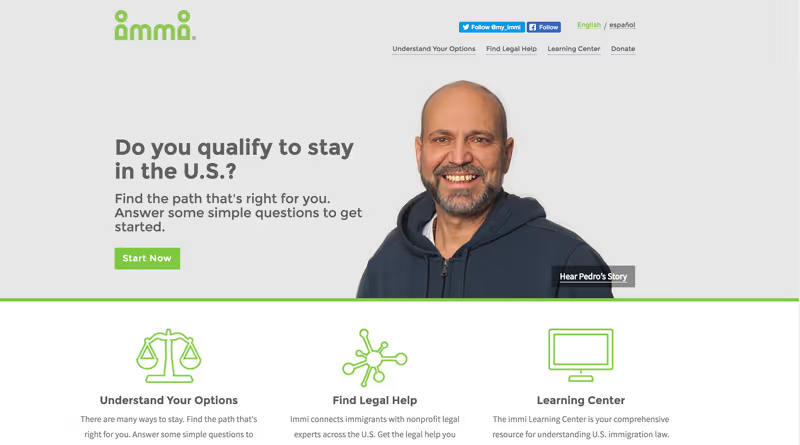
Do you qualify to stay in the U.S.? - Find the path that's right for you. Answer some simple questions to get started.[/caption]
Little know secret, being informed about your immigration options is complicated.
Ok maybe that's not a secret, and maybe it doesn't have to be complicated.
Immi's somewhat clunky slogan tells you exactly what they do. However, their online screening tool is more like the name of this innovative nonprofit - user-friendly and techy. Immi's online screening tool allows immigrants to easily gain a better understanding of their legal options. After completing the survey, your results are sent to your phone or email. Imagine, 1.5 million undocumented immigrants having access to a tool that explains what benefits they are personally eligible for.
In addition, despite being less than a year old, Immi's has one of the best immigration Learning Centers and Legal Help directories, both powered by the vast data and experience of its two parent organizations: Immigration Advocate Network and probono.net. These two organizations have partnered before on several projects, and their past working relationship allowed them to respond with serendipitous timing to the sense of urgency catalyzed by American political rhetoric.
Local organizations can be found by Immi's Legal Help tool, which provides a user-friendly search engine to find helpful organizations nearby, primarily with legal help. In addition to filtering by location, you can also narrow your search by organizations that provide the specific services you need (including non-legal), populations served and other relevant criteria. Rest assured, all non-profits found at Immi have been recognized by the Board of Immigration Appeals (BIA), or at least have staff that are included in their directory.
Honorable Mentions
HAIS
HAIS has study guides for citizen test available and subtitled prep videos in six languages: Arabic Nepali, Serbo-Crotiaon/Bosnian, Somali, Spanish, Vietnamese
Americans for Immigration Justice
A unique combination of free direct services, impact litigation, policy reform, and public education at local, state, and national levels.
Upwardly Global
They work with skilled immigrants to find employment in the United States
The Young Center
This organization upholds immigrant child rights, they have a referral function on their page if you know of an immgrant child that could use their services
What to do if you have lost your Passport
For information on how to replace your passport and visa, follow the steps outlined below.
General Immigration Information
Passports and visas are official travel documents that all foreign citizens coming to the United States must have to show one's country of citizenship and legal status in the U.S., as well as to enter and leave the country. Losing these important documents can be very stressful - here's a short guide to help relieve some of that stress and move forward.
First of all, don't worry. Your visa is needed only to enter the United States; it has no relevance to your stay here after entry. In other words, if you happen to lose your visa while already in the country, you may remain the entire length of your authorized stay (as shown on your admission stamp or Form I-94, Arrival/Departure Record) without any problems. You will, however, need a valid passport to depart the United States and enter another country. For information on how to replace your passport and visa, follow the steps outlined below.
Search
Make sure your passport/visa are actually lost and not just misplaced. Search your home, luggage, wallet/purse, and anywhere else you may have stored them. Ask family members and travel partners if they have any knowledge of the documents' location.
File a Police Report
If you still cannot find your passport/visa, go to your local police station and report your document(s) lost or stolen. If you have copies of the original documents, bring them with you. You will then be issued a police report detailing the incident. Make a copy of the report for your own records.
Report Loss of Your Passport
Contact or visit your country's embassy or consulate in the U.S. to notify them of your missing passport and for instructions on how to obtain a new one. If you think your passport has been stolen, reporting this will help guard against fraudulent use. It is extremely important that you perform a thorough search before you report it lost or stolen, because once reported, your passport is no longer valid for travel. However, if you find your passport after having reported it lost or stolen, it may still be used as a valid form of personal identification.
- If you do not have another form of photo identification, contact your country's embassy/consulate to find out what alternate documents you may need.
Report Loss of Your Visa
To report your visa lost or stolen, email the U.S. Embassy or Consulate outside the United States that issued your visa. Go to the U.S. Embassy or Consulate website to locate the corresponding email address and contact information. Be sure to include your full name, date and place of birth, current address in the United States, and your email address. Clarify whether your visa was lost or stolen, and if you have a copy of it include it in the email. If you know the category of visa you have or your passport number, include these too.
Like your passport, if you have already reported your visa as lost or stolen to the U.S. Embassy or Consulate but later find it, your visa will be invalid for future use, and you will have to apply for a new one.
Applying for a Replacement U.S. Visa
For future travel into the United States, you will need a new visa. Unfortunately, lost or stolen visas cannot be replaced in the United States. For replacement, you must apply in person at a U.S. Embassy or Consulate abroad. When you apply for a visa replacement, you will need:
- A written account documenting the loss of your passport and visa
- A copy of the police report
A Few Things to Keep in Mind
- Again, you won't have any problems remaining as long as originally authorized, but you will need a new passport before you return home. The replacement process can take time, so begin as soon as possible to ensure that you have a new one in time for your return trip.
- Some embassies and consulates may offer faster processing procedures, so ask if them if there is a way to process the new passport quickly.
- Traveling while you wait for your new passport can be risky, so try to postpone travel plans until you receive your new passport.
- If you need to complete an I-9 for employment (employment verification form), wait until you have your new passport before processing the form.
One Last Tip
We recommend making copies of all travel documents in your possession as soon as possible after arriving in the United States. These include your passport biographic page, visa, and admission stamp or Form I-94. That way, if you do lose one or all of these important documents, the recovery/replacement process will be that much easier. Remember to stay calm, follow the procedures outlined here, and respond to all questions and embassy/consulate employees honestly and accurately - before you know it, you'll be along your way as if nothing ever happened. Safe travels!
What happens after submitting your I-751 - Petition to Remove Conditions?
What to expect after submitting Form I-751, Petition to Remove Conditions
Green Card Renewals, Replacements and Removal of Conditions
Last Updated: January 15, 2020.
The USCIS provides “conditional permanent resident status” and a two-year green card to immigrants married to a Legal Permanent Resident or United States Citizen. Those who wish to attain their status as a Lawful Permanent Resident must file the Form I-751 - Removal of Conditions Application. Now, what happens after you submit your Form I-751?
Receipt of Application
Within three weeks from submitting your I-751, you will receive a receipt by mail. This receipt will confirm the USCIS has received your form and has begun normal processing. This receipt is called Form I-797 - Notice of Action. It also serves as an extension to your conditional residence for a year while your I-751 is being processed. It will come with a ten-digit number that you can use to check the status of your application. Both the I-797 and expired green card are necessary to prove conditional residency status. You should also get an extension stamp or an I-551 stamp in your passport. You can get these from your regional USCIS office. To read more about that, check out this article. Should USCIS reject your application or need more information, they will send a Notice of Action or Request for Evidence.
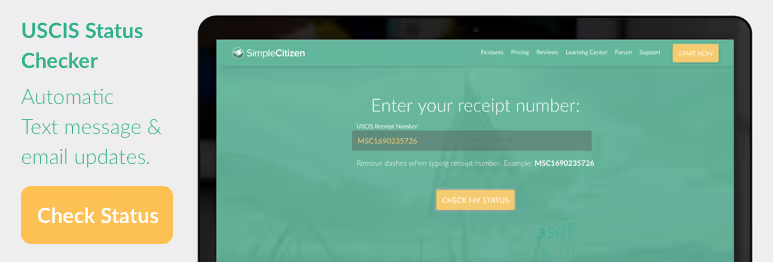
Biometrics Appointment
>> What Happens at the Biometrics Appointment?
Within four weeks of filing, you will receive a notice detailing a biometrics appointment. The notice will include the USCIS office where you will appear, the time of appointment, and the date. At your biometrics, you will record your fingerprints, photograph, and signature. (Keep in mind that although you may travel after having submitted your forms and are waiting for USCIS response, it is crucial you attend your biometrics appointment) The appointments are approximately 30 minutes, and your notice will provide details on what you will need to bring. Learn more about the biometrics appointment.
Within 5 months of your biometrics appointment, you won’t receive any further notices unless the information provided previously was unsatisfactory or needs to be re-recorded or re-submitted for any other reason.
Appointment Notice for Interview
>> How To Pass A Marriage Green Card Interview
Within 6 months, some applicants will receive an interview requirement notice. If you submit your own I-751 form, it will take 6-8 months to process; however, if your spouse submits the waiver application, it can take up to 12 months. A waiver application undergoes a more stringent screening process and often requires an interview. If the waiver application is accepted as legitimate, they will not feel a confirming interview is necessary. This is why providing valid proof of relationship (e.g. a marriage license) is important when submitting your I-751. Should you be asked to attend an interview, preparation counsel from an attorney prior to the interview is recommended. If you have used Simple Citizen and would like to schedule a call with our legal team, reach out to us at support@simplecitizen.com.
Petition to Remove Conditions granted and green card issued
Within 8 months, your application should be fully processed, and your Petition to Remove Conditions granted and green card issued. Keep in mind that the time frame is different for each form, and the entire process may take up to a year. (Remember, you can check your application’s status here.) If your mailing address changes after you’ve submitted your I-751, you should call USCIS at 1-800-375-5283 to change your record. If you feel like your form request has extended beyond the regular processing time, visit this USCIS website.
What happens at the Biometrics Appointment?
An overview of what to expect during your USCIS biometrics Appointment.
General Immigration Information
Last Updated: January 15, 2020.
The biometrics appointment sounds technical and is often intimidating for people, but it's usually a very straight-forward appointment! In order to confirm your unique identity, the USCIS collects data for many reasons, one is to ensure that whenever YOU sign a document in the future, it really is you! It also helps deter people with criminal records from applying for USCIS benefits for which they are not eligible. Here are some of the most common questions about the appointment, as well as some common problems and how to prepare for them.
What exactly does “biometrics” mean?
Biometrics is the process of capturing your unique features by putting your fingerprints, photograph, and signature on file so that the USCIS can confirm your identity in the future.
Who has to attend the biometrics appointment?
The USCIS can require biometrics from any applicant, sponsor, or beneficiary living in the US for any immigration or naturalization purposes. After filing your application, petition, or request you will receive a notice telling you where and when you need to go for the appointment.
If you are under the age of 14, you may choose to sign if you are able to, or a parent or legal guardian may sign on your behalf.
How should I prepare for the biometrics appointment?
It is a good idea to make copies of your application, petition, or request. You may bring a copy (as the USCIS will not provide you with one), but you should also do this to keep for your records and to review your forms before the appointment. Your personal appointment notice will include specific instructions on what you need to bring. Everyone MUST bring the ASC appointment notice (Form I-797C) and a valid photo ID (like a green card, passport, or driver’s license).
For most people, the biometrics appointment is nothing to be worried about! If you think you have a criminal background, you may want to contact a lawyer for further advice.
What should I expect at the biometrics appointment?
You will first be asked to reaffirm the following “Acknowledgement of Appointment at USCIS Application Support Center” statement:
I declare under penalty of perjury that I have reviewed and understand my application, petition, or request as identified by the receipt number displayed on the screen above, and all supporting documents, applications, petitions, or requests filed with my application, petition, or request that I (or my attorney or accredited representative) filed with USCIS, and that all of the information in these materials is complete, true, and correct.
If you cannot reaffirm that this is true, your appointment will be rescheduled until you can refile your paperwork.
Given that everything you submitted was true, the USCIS will capture your fingerprints (either 2 or all 10, depending on the type of ASC notice you received), your photograph, and your digital signature.
What if I am applying from outside the United States?
The process is a bit different in this case. When you file your Application for Naturalization (Form N-400) you have to include your completed fingerprint cards (Form FD-258) and two passport style pictures. For specific instructions and details regarding those, look here and here, respectively.
If you are active duty military or are applying under sections 328 or 329 of the Immigration and Nationality Act and you live outside the U.S., look here for more information.
What if I require assistance?
Many people require assistance for the appointment. Here are some of the common issues people may have, and the solutions provides by the USCIS to make this process as easy as possible.
Common Concerns
I can’t speak English.
You may bring someone with you who can translate for you.
I can’t read English.
For the “Acknowledgment of Appointment” statement, you should go here to select the language you can read and review the translation before your appointment.
I have a disability that prevents me from signing my name.
They will accept any mark (such as an “X”) as a signature. If you cannot provide this, there are other procedures in place to capture your biometrics.
I have a disability that will require further assistance.
You may bring a family member, attorney, or accredited representative to assist you.
I have a disability that will require further accommodation.
As soon as you arrive you should speak to the ASC immigration services officer for help. There are tons of accommodation services available, but you will likely need to request them in person. You can also try contacting your local Application Support Center before the appointment. Their contact information should be on your appointment notice.
Why might I have additional biometrics appointments?
Because biometrics data is only considered valid for 15 months, you may be required to attend more than one if your application is pending for longer than 15 months. You will also have to attend a new appointment should you apply for a different USCIS benefit.
What if I am uncomfortable with the government having my fingerprints and other personal data?
Unfortunately, if you refuse to provide anything that is asked of you during the biometrics appointment, your application will more than likely be refused. Biometrics are being used increasingly around the world and seem only to be gaining popularity by international law enforcement and immigration services, so you will likely be asked to provide similar levels of data to obtain a visa or green card in most countries.
Request for Evidence (RFE)? What To Do
What is a Request for Evidence and what does getting a letter of Request for Evidence mean for you?
Frequently Asked Questions
Updated: October 1, 2021
What is a "Request for Evidence?"
What is a Request for Evidence and what does getting a letter of Request for Evidence mean for your application?
The letter means USCIS needs more information to process your application. RFEs are fairly common but are serious in nature. They must be responded to in order to keep your application on track. But don't worry, getting an RFE does not mean your case is denied and preparing a response can be fairly simple. Keep reading to learn what to do if you receive an RFE.
What happens if I get a Request for Evidence?
USCIS will send a letter to the address you've provided that explains what additional information they need from you in order to move forward with your case. For tips to avoid an RFE click here.
The RFE will have a deadline. You must respond by the deadline. This deadline is usually in the first paragraph and in BOLD. The typical time to respond is about 87 days, but USCIS will sometimes give a specific date or timeframe for you to respond.
Example: An RFE may say something like, “you must submit the information within 87 days”. Treat this timeline seriously and do not delay submitting the necessary information or evidence that they are requesting.
When you are getting ready to send in the requested information indicated in the RFE, make sure to review the letter carefully. You must respond to all information requested at one time. USCIS will not allow you to send more evidence later. You only get one response. Make sure that you attach a cover letter explaining what you are sending in, why you are sending it in and any other information that might be helpful.
The RFE will include instructions for where to send the response. In some cases you'll need to include the original RFE letter with your response, while in other cases USCIS only requests a copy of the RFE letter. Whether you are required to send the original or the copy, attach it to the very top of your response. Make sure that it is the first page and the first thing that the USCIS officer sees when they open your application.
The RFE should include an address for you to send the response packet to. Make sure that you send the RFE response to the address listed. It will be different than the original USCIS address that you sent your application to.
Let us know
Immigration issues can be tricky. If you have any questions about your specific Request for Evidence or your immigration case, there are experienced professionals that can help.
If you are a customer of SimpleCitizen and you've received an RFE please reach out to us via live chat, email or phone. RFE responses are included with the Professional package we offer. Do not hesitate to reach out and ask for help.
Self-Employed Sponsor and USCIS Form I-864, Affidavit of Support
What you need to know about having a Self-Employed Sponsor fill out Form I-864.
Green Card Application
Last Updated: January 15, 2020.
Self-Employed Sponsor and Form I-864
What you need to know about having a Self-Employed Sponsor fill out Form I-864. One of the requirements to get a green card is having a financial sponsor file the I-864, Affidavit of Support. This USCIS form is basically a contract between the financial sponsor, the immigrant applicant and the US government. As part of the contract, the sponsor must meet certain income requirements to qualify as a financial sponsor for the immigrant. Like every form on the green card application, several documents must be submitted as supporting evidence for the information provided in the application.
Submitting supporting evidence for a sponsor that is currently employed is fairly straightforward. The sponsor needs to attach their most recent federal tax return, a letter from their employer and pay stubs for the past 6 months. These requirements become useless when the sponsor is either self-employed or retired.
Self-Employed Sponsors & Form I-864 Supporting Documents
The USCIS actually has a few guidelines when it comes to proving an income amount for a sponsor that is self-employed or a business owner. The USCIS suggests that self-employed sponsors should attach the following photocopies of documents to their I-864, Affidavit of Support:
- Total and Complete Tax Return: All schedules associated with the federal return including Schedule C (Profit/Loss from Business), Schedule D (Capital Gains/Loss), Schedule E (Supplemental Income/Loss) and Schedule F (Profit/Loss from Farming).
- Business Licenses and registrations.
- Signed and dated statement about the nature of the business and the sponsors involvement.
- Bank Statements for the previous 6 months.
Retired Sponsors & Form I-864 Supporting Documents
If the sponsor that is submitting the Form I-864, Affidavit of support is retired, a similar problem exists. Again, the goal for a retired financial sponsor is to simply provide independent evidence that establishes a steady flow of income matching the amount reported in the Form I-864. This can be accomplished by providing the following documents:
- Recent Pension Statements and Current Pension Payment Receipts
- Social Security Documents that indicate payments
- Complete Tax Returns
- Bank Statements for the previous 6 months
As you are working to complete your green card application and fill out a correct Form I-864, make sure that you are avoiding some of the other pitfalls of the financial sponsor for a green card. Making sure that you are calculating the household size correctly or including the accurate income amounts are a few of the important things to remember when working on this application. SimpleCitizen is a do-it-yourself tool to help you avoid these common mistakes. We are the only truly comprehensive service, guiding users from signup to citizenship while ensuring their application is correct and complete at every stage.

